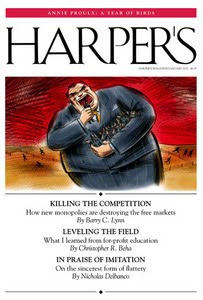Regular “What’s the Diehl?” readers know that my current favorite magazine is The Sun, an independent, nonprofit, ad-free monthly magazine published and edited since 1974 by an interesting fellow by the name of Sy Safransky with whom I’d love to spend a few hours dining, drinking and discussing anything he wanted to discuss.
I wonder, though, how many of you know that my second favorite magazine is Harper’s, with its cool “Harper’s Index,” interesting “Findings” and compelling, impressive writing? Harper’s was first published in June of 1850, making it the second-oldest continually published monthly magazine in the country (only Scientific American is older).
Did you know that during its history, Harper’s has included writing by Winston Churchill, Woodrow Wilson and Teddy Roosevelt? Did you know that it’s featured top-tier literary luminaries like John Updike, Norman Mailer, David Halberstam, William Styron, Bill Moyers, Horatio Alger, Noam Chomsky, Robert Frost, Horace Greeley, Naomi Klein, Jack London, John Muir (founder of the Sierra Club), Sylvia Plath, John Steinbeck, Booth Tarkington, Hunter S. Thompson, Mark Twain, Kurt Vonnegut, John Updike, E.B. White, Howard Zinn and J.D. Salinger?
Were you aware that the first appearance in print of portions of Moby Dick occurred in Harper's in October of 1851 under the title, "The Town-Ho's Story” or that Harper’s published Seymour Hersh's reporting of the My Lai massacre – arguably the darkest moment of the Vietnam War – in the 1970s? How about that "Harper's Index" – the extremely popular list of interesting and often ironic statistics that appears in the front of the magazine each month – didn’t premiere until 1984?
I spent just 60 minutes perusing the February 2012 issue and have already learned the following:
- Babies as young as eight months enjoy seeing bad puppets punished.
- It turns out that popular British poet Philip Larkin – whom I just discovered although he died back in 1985 – was in real life a racist, misogynist and “partisan of the ultraright.”
- The City of New York’s medical examiner removed the brain of a 17-year-old boy – he had died in a car accident – without his family’s knowledge; it was discovered a month or so later when his schoolmates toured the morgue and spotted the organ floating in a jar with his name on it.
- Reporters covering Occupy Wall Street protests have been advised to carry bandanas soaked in vinegar to neutralize tear gas, wear comfortable boots that they can run in, leave camera tripods behind if they have to flee, and stay away from police horses because they kick and bite.
- The average one percenter enjoys a $66,384 windfall each year under Dubya’s tax cuts.
- Voting booths of various types and sizes can be found in diners, garages, greenhouses, shopping malls, convenience stores and even greeting card shops on Election Day in the United States.
- The real name of Diane Keaton, the actress who starred in Woody Allen’s 1977 hit movie “Annie Hall,” is DiAnnie Hall. “Keaton” was her mother’s maiden name.
- Ornithologists discovered that the erections of ostriches are bloodless. (I would like to have been a fly on the wall during those laboratory tests.)
- Eighty-six percent of National Football League players experience financial distress within five years of retirement.
- An average of 18 U.S. veterans commit suicide each day.
- U.S. millionaires received $89 million in federal land preservation grants for ranches and estates in 2009 and 2010.
- There’s a one-in-three chance that a page in Core of Conviction, Michele “Crazy Eyes” Bachmann’s memoir, contains an exclamation point.
- An estimated 11,000 jobs are created by every billion dollars of U.S. military spending; the number of jobs rises to 27,000 when the same amount is spent on education.
- The Penthouse Club, a “gentlemen’s club” in the heart of Tampa Bay, Florida, has spent a million bucks on renovations in preparation for this summer’s Republican National Convention.
All this knowledge for the newsstand price of $6.99/issue.
Although Harper’s is slightly left-of-center, I was momentarily worried that it was in fact owned by the Koch Brothers or Sun Myung Moon or someone equally undesirable to me, but I was pleased to find that it’s been owned by the Big Apple-based Harper’s Magazine Foundation since 1980 – the year I graduated from Ernest W. Seaholm High School in Birmingham, Michigan – and is truly an “independent voice in American culture.”
Harper’s – which celebrated its Sesquicentennial in 2000 – has won a number of National Magazine Awards, an Amnesty International Media Award, a Thomas Paine Journalism Award, a Media Eclipse Award and several O. Henry Awards, among other honors. If there were a “What’s the Diehl?” Award for The Most Interesting, Informative Monthly Publication Ever, Harper’s would snag one in a heartbeat.





My favorite magazines are currently The New Yorker, The Nation and Popular Science, but I'll have to revisit Harper's, which I haven't read recently. Also The Sun, which I somehow missed.
ReplyDelete